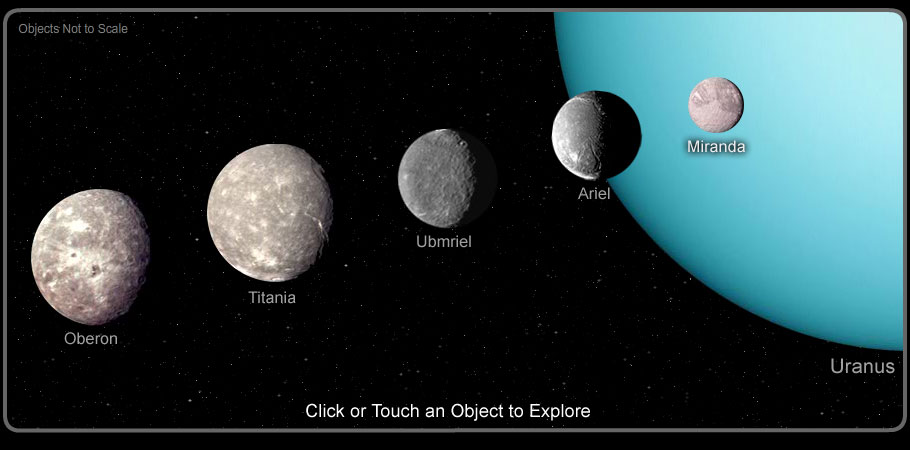The Blue Gas World
Continuing our outward journey, we encounter the seventh planet from the Sun. It is a beautiful yet nearly featureless giant, blue green sphere. The outer layer of thick, blue gas gives no hint as to what might lie beneath. We have left the realm of the gas giants and entered the domain of the ice giants. This planet is a little bit smaller than its close neighbor, Saturn, and is surrounded by a very thin layer of small delicate rings. On closer inspection, we find this mysterious world to be tilted on its side for some strange reason. In orbit around the planet, we find 27 moons of varying sizes and shapes. Five of these natural satellites are large enough to explore in detail. This is the planet Uranus and its system of rings and moons.
More Rings
The planet Uranus has a very thin and faint system of rings. It was the second planet in the Solar System found to have rings. The first of these rings was observed in 1977 by by James L. Elliot, Edward W. Dunham, and Douglas J. Mink using the Kuiper Airborne Observatory. The discovery was actually made by accident. The two astronomers had planned to study the occultation of a star by the Uranus. However, as the planet slowly drifted in front of the star, they saw that the star actually blinked out of view five times before it was covered by the planet. They were able to conclude that Uranus must be surrounded by a system of five rings. The rings were confirmed by the Voyager 2 spacecraft in 1986, and two new rings were discovered, bringing the total number to seven. Since then, the Hubble Space Telescope has discovered six more rings bringing the total now to 13. These new discoveries have nearly doubled the size of the ring system since the new rings are much farther out then the previous ones.
Unlike the dazzlingly bright rings of Saturn, the rings of Uranus are composed of dark particles that range in size from dust to chunks just a few feet, or less than a meter across. They are extremely narrow, measuring only a few miles wide. Because they are so dark, it seems unlikely that these rings are composed of pure water ice like the rings of Saturn. Although their exact composition is not known, they are probably made up of a mixture of ice and some type of dark material. Many astronomers believe that these rings may be the remains of a moon that was destroyed in a catastrophic collision of some unknown origin.
A Sideways Planet
Uranus is different from all of the other planets in the Solar System. It is the only planet that rotates on its side. The planet has a tilt of 97.77 degrees. Compare this to the tilt of the Earth, which is only 23.5 degrees. This extreme tilt gives the planet seasons unlike anything else in the Solar System. As the planet orbits the Sun, each of the poles and the equator face the Sun at different times in its long trip around its parent star. Needless to say, this gives the planet some very unusual weather patterns that cause drastic changes throughout the Uranian year.
Astronomers are divided as to the cause of this unusual tilt. Some believe that a large object, possibly an asteroid or an errant moon, may have collided with the planet knocking it on its side. Others think the extreme tilt may be caused by complex gravitational interactions between Uranus and its neighbors, Saturn and Neptune.
Exploring the Uranian System
The planet Uranus has been observed since at least the late 17th century, although it was most often mistaken for a star. English astronomer John Flamsteed observed it in 1690 and classified it as a star in the constellation Taurus. It was officially confirmed as a planet by Sir William Herschel in 1781. He originally believed it to be a comet, but additional observations revealed to indeed be a planet.
Because of its extreme distance from the Earth, the Uranian system has only been visited by one spacecraft. In 1986, Voyager 2 entered the Uranian system and gave us our first close-up views. Up to this point, Uranus had only been visible as a tiny blue green dot in telescopes.
Voyager 2 made its closest approach to the planet Uranus on January 24, 1986. During this brief flyby mission, the spacecraft discovered 10 new moons and studied the planet's unique weather. It also studied the magnetic field, and gave us our first views of the surface of the five largest moons. Although the delicate ring system of Uranus had been discovered in 1977, Voyager 2 was able to find two additional faint rings.
There are currently no new missions planned for the exploration of Uranus. NASA continues to look at the feasibility of sending a future spacecraft to the Uranian system, but other missions have taken priority. Since Uranus is not currently a candidate for life, NASA is concentrating on future missions to Jupiter and Saturn, where astronomers believe that life could exist on some of these planets' moons.




